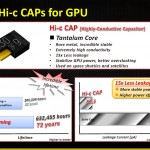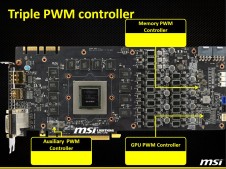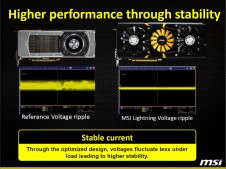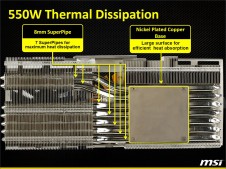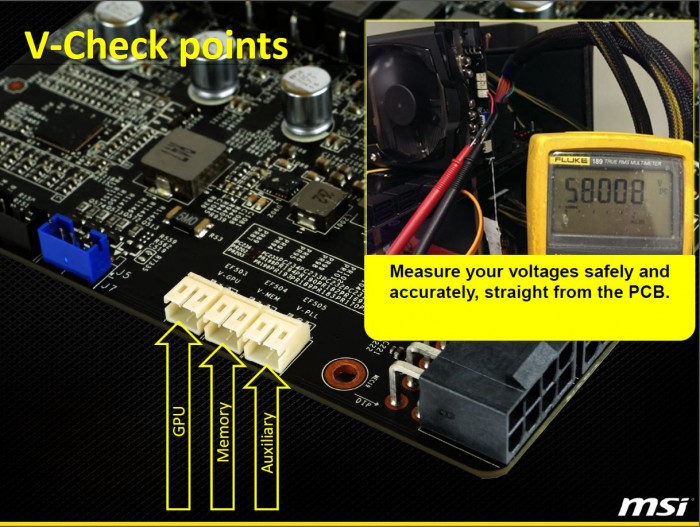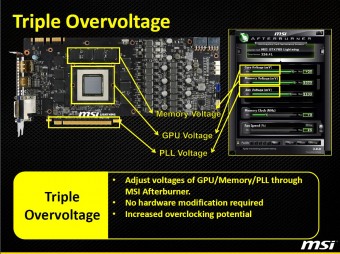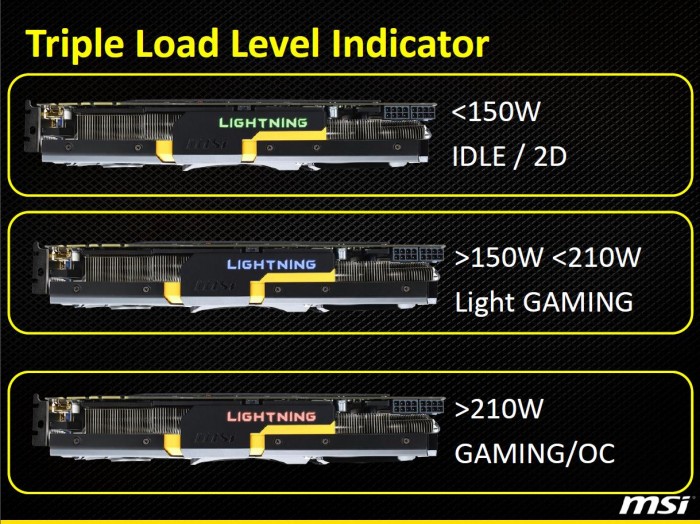MSI GeForce GTX 780 Lightning

The MSI GTX 780 Lightning comes to market at $769.99 from Newegg at the time of this writing which places it as the highest priced air cooled card for 780 models with the next being EVGA’s Classified model at $699.99. With that noted and knowing the stiff competition to begin with I must say that MSI has to release a real show stopper hear to justify such an increase in cost over other 780 options.
Key Features
Military Class 4 Components
MSI has long touted the Military Class components on their cards due to the fact that they are specially tested components, not just by them but by a third party testing center according to the enclosed certificate. “Military Class components” sounds nice, but are they really necessary on a card or motherboard? Honestly, no as most times the reference components are good enough to do their job. However, they are not designed to push the limits to the extreme. The answer is better and stronger components. Most manufacturers worth their salt will use better components, so in order to try and stand out, MSI uses “Military Class” components in an attempt to ensure better hardware reliability.
Military Class Component Testing
When MSI puts military class components to the fire they are not joking as they come to the table claiming to have passed multiple tests following Mil spec (MIL-STD-810G) Tests including:
- Temperature Shock testing: Sudden thermal changes which can normally wreak havoc on electrical components are fully tested on these components to ensure they can last through some of the worst conditions like lets say what the extreme enthusiasts community may employ them for. Although I’m sure the Lightning card will be more in that category its still nice to know its there.
- Humidity Testing: Testing of components in different humidity conditions can make a big difference as to the capabilities of the cards as different areas can have much different environments and not every deployment will be like a sterile lab and knowing they can take that kind of abuse once again is a major plus.
- Vibration tests: This one is a little nuts but being in California I guess if I have an earthquake I can ensure the shaking wont affect the components.
- Low Pressure Testing: This once again is a little extreme as deployment for different elevations especially extreme enough to require low pressure testing is gonna be extremely rare if ever but it will handle it.
- High Temperature Testing: This one should be a standard for every component in a high end PC as thermals are the enemy of every enthusiasts rig so I like to see such attention paid here.
- Low Temperature Testing: Once again I think something more targeted at the Lightning model, but the fact that they test these cards to withstand LN2 benchmarking temperatures tells me that under standard gaming stresses this card is gonna run and keep on running.
- Shock Testing: This is once again more extreme as these are similar to drop or rough impact testing which well even if the card survives I’m sure other components may not fare so well in this kind of scenario.
So what we can take from this is that this card may survive the nuclear apocalypse or even a Zombie infestation but well in the case of a nuclear apocalypse this card looks like it could probably take it, and with The North Korea situation maybe you can hide behind a stack of these cards.
Enhanced Power Design
MSI via the lightning series has always pushed ridiculous VRMs on these cards and the 780 lightning is in no way an exception to this. The VRM is simply massive in every respect and uses top quality components to ensure great lifespan or great performance when pushing clocks with plenty of power delivery potential should you feel the need to push for world record benchmarks on subzero cooling. Dont forget that in the box there is actually a VRM cooler specifically made to spread the heat out from the VRM in the case that a LN2 pot is installed to assist with VRM cooling duties.
One thing i feel is very much worth noting is that the power design is completely changed compared to what we have seen before in that the memory power is normally pulled from the PCIe slot itself and therefore any sort of noise or ripple caused by other board components sharing this power plane could make its way to the card memory which means when overclocking these said ripples or power distortions could theoretically make their way to your card and cause instability or hamper your overclocking efforts. MSI has decided to move the memory power feed to the external PSU PCIe power connectors loading to ensure more stable power consistently across the board.
There is some caveats I see here and this is overall power delivery as removing the slot as a power source means that you are inherently removing a source of up to 75W which means that overall the headroom you would have for overclocking by employing dual 8 pin PCIe Connectors is now lost and you might even be at a deficit with such a configuration should you want to really push the card. The standard 6 pin PCIe connector is rated at 75W while an 8 pin rated for 150W. so by adding a dual 8 pin arrangement where normally a 6 and 8 would reside but then moving what was normally powered by a slot to the PCIe PSU power you are eliminating or at least limiting the headroom you had created with such a configuration.
This is not to say that the design is bad but I would like to have seen a 8/8/6 configuration where the memory has a 6 pin of its own, and I know many will say this is crazy or unnecessary but when talking about a card which is destined to be benched and benched hard you cannot deny that having such a configuration is not exactly a crazy idea as having plenty of power on tap for the most strenuous scenarios really is what cards like this are all about and in order to ensure there is plenty of headroom sometimes such methods are necessary.
Now that we have covered my concerns on that front I will say that moving the memory to a PSU feed I feel is a good idea as it eliminates having the card rely on the long and sometimes small traces of a motherboard to feed it power. This is the kind of innovation I like to see from flagship or uber high end models such as this I just think a little forethought to the possible implications of the design would be made.
GPU Reactor
The GPU reactor is an interesting piece which I have seen before and I really do like the idea in theory as it in basic terms gives you a mini PCB on the rear of the PCB directly behind the GPU with some POSCAPS in place which allow stiffening of the power to the GPU directly onto the rear where it has the best direct shot to feed the GPU with minimal interference. This in theory will allow a better stiffening effect for quick load transitions and even possibility of cleaning up some ripple in the GPU power feed.
New Triple Force Cooling Design
We have always known MSI for their Twin Frozr designs which are dual fan designs that offer great cooling performance while being dual slot to ensure optimal fitment in any multi card arrangement. Today we see the Triple Force cooler designed with three fans two fo which are 90mm outer fans while the middle yellow fan is a 80mm model.
Here you can see that the new Triple Force model has many improvements to ensure it not only cools well but cools efficiently. Employing 8x Superpipe heatpipes means that a huge amount of heat can be pulled away from the GPU and quickly evacuated through the cooling fin array.
Add to this the fact that the Lightning has a backplate and front plate system which work together to sandwich the card PCB and components to provide not only a stiffer card overall but also cooler components via the units acting as heatsinks as well and the card is designed to be not just rock solid in rigidity but in functionality.
Here you can see the overall GPU cooler design is made to handle up to 550W of thermal dissipation which is simply huge. This I would say is probably one of the mmost capable looking cooling components I have seen on a GPU to date and I have seen alot of very nice cards but this one is simply beefy and the design and layout is simply very efficient.
The fin array has special grooves stamped into each fin in a shallow bend groove which allow channeling cooling airflow to ensure maximum cooling capability and maximum cooling efficiency from the airflow being used and I think designs like this will also ensure more heat is averted and therefore less fan speed needed which in turn may lead to less noise output.
Dual Fan Controllers
MSI did a very interesting thing when it comes to fans on the 780 Lightning in that in employs two separate fan controllers with one of them controlling the two outer 90mm Black fans while a second controller modulated the middle 80mm yellow fan. this is interesting as now you can set different fan speeds to target specific sections of the card as needed which may lead to a reduction in overall noise output and better controlled cooling of the card.
MSI even introduced a special fan controlling software which can modulate the middle and outer fan pairs separately to manually tune your card as needed or even to simply monitor fan duty under loaded conditions.
Form-in-one Heat sink
MSI includes a backplate and even a front mounted plate which secure together via screws to keep the PCB sandwiched between them which offers a very high level of rigidity to the card and makes for a simply solid feeling card when handling the unit. On top of this the Form in One heatsink also works as a heatspreader for the board components allowing for active cooling of the VRM components and memory while the rear works as a shield for the rear PCB components. Add to this the airflow from the Triple force cooler which passes over the plates and you can see that the units can work very well as a heatsink
OC Enhancements
Here you can see one of the key components that makes the Lightning special which is the Dip switch used to switch between the standard high performance VBios which allows excellent air cooled gaming and performance overclocking while the flip of a switch enables the LN2 VBios which allows for elimination of many of the GPU protections that normally would hamper overclocking performance in extreme overclocking subzero cooled situations.
The 3×3 OC Kits as MSI calls them have to do with special features which further help with the overclocking expedition. Firstly would be the “Triple Overvoltage” from within the MSI Afterburner program. This allows for full tuning of GPU Voltage, Memory Voltage and even AUX voltages to better squeeze every bit of performance from your GPU.
Triple Temp Monitoring which allows for monitoring of not just the GPU but also the VRM and memory to allow full awareness of your card operating condition while benchmarking or even just while doing some heavy gaming.
Also V-Check points allows for attachment of probes to allow real time monitoring of set voltages directly at the card hardware level. This ensures you can see any fluctuation or even voltage not being applied properly in loaded scenarios to help diagnose issues while benchmarking.
Here you can see the V-Check points which when the supplied lead is attached allows direct voltage readings from the GPU, Memory and AUX even during benchmark runs without the need for software.
MSI Afterburner
MSI offers its own software utility. MSI Afterburner is co-developed with Rivatuner which is very similar to what the other top manufacturers are offering.
There we see it above with multiple options including voltage control and power limit controls to ensure our overclock ceiling is just a little bit higher. Do note that some options may not show up right away and need to be enabled in settings otherwise they will be hidden.
here is the area where afterburner and the MSI cards can gain some definite lead is the ability to adjust the three voltages or “Triple Overvoltage” options which allows for real time adjustment and tuning of key voltages to really push the limits of your card.
also the triple temp monitor as mentioned before is nice so you can keep an eye for any hot spots during heavy loading.
Here is a neat little feature we have seen before from other cards which is that the Lightning top logo is backlit and depending upon loading conditions the backlighting will change color to coincide with the amount of loading from idle(Green) to extreme or OC loading(Red).
Review Overview
Performance - 95%
Value - 85%
Quality - 95%
Features - 95%
Innovation - 90%
92%
The Lightning is an amazing benchmarkers card with everything including the kitchen sink thrown in. This card simply bleeds innovation and stands waiting for the next splash of LN2 to set its pace.
 Bjorn3D.com Bjorn3d.com – Satisfying Your Daily Tech Cravings Since 1996
Bjorn3D.com Bjorn3d.com – Satisfying Your Daily Tech Cravings Since 1996


